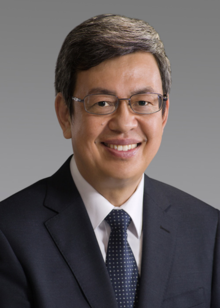Vice President of the Republic of China: Difference between revisions
No edit summary |
|||
| Line 24: | Line 24: | ||
[[Image:Taiwan 2009 Taipei Presidential Palace FRD 7172.jpg|thumb|250px|The [[Presidential Building (Taiwan)|Office of the President of the Republic of China]], located in [[Zhongzheng District]], [[Taipei City]], also houses the office of the Vice President.]] |
[[Image:Taiwan 2009 Taipei Presidential Palace FRD 7172.jpg|thumb|250px|The [[Presidential Building (Taiwan)|Office of the President of the Republic of China]], located in [[Zhongzheng District]], [[Taipei City]], also houses the office of the Vice President.]] |
||
The '''Vice President of the Republic of China''' ({{zh|t=中華民國副總統|p=Zhōnghuá Mínguó Fù Zǒngtǒng|poj=Tiong-hôa Bîn-kok Hù-chóng-thóng}}) is the second-highest executive official of |
The '''Vice President of the Republic of China''' ({{zh|t=中華民國副總統|p=Zhōnghuá Mínguó Fù Zǒngtǒng|poj=Tiong-hôa Bîn-kok Hù-chóng-thóng}}), commonly known as the '''Vice President of Taiwan''' is the second-highest executive official of Taiwan. The existing office was created in 1948 under the [[Constitution of the Republic of China|1947 Constitution of the Republic of China]]. After the [[Kuomintang]] lost [[mainland China]] to the Chinese [[Communist Party of China|Communists]] during the [[Chinese Civil War]], the government, along with its presidency, retreated to Taiwan. The [[Communist Party of China]] has since established the [[People's Republic of China]] on the mainland side. [[Chen Chien-jen]] is the current Vice President of the [[Republic of China]]. |
||
==Powers== |
==Powers== |
||
Revision as of 22:58, 26 June 2019
| Vice President of the Republic of China | |
|---|---|
| 中華民國副總統 | |
since May 20, 2016 | |
| Style | His/Her Excellency (閣下) |
| Term length | Two consecutive 4-year terms |
| Constituting instrument | Constitution of the Republic of China |
| Inaugural holder | Li Yuanhong (Provisional) Li Zongren (1947 Constitution) |
| Formation | 20 May 1948 |
| Succession | First |
| Website | english |
 |
|---|
|
|


The Vice President of the Republic of China (Chinese: 中華民國副總統; pinyin: Zhōnghuá Mínguó Fù Zǒngtǒng; Pe̍h-ōe-jī: Tiong-hôa Bîn-kok Hù-chóng-thóng), commonly known as the Vice President of Taiwan is the second-highest executive official of Taiwan. The existing office was created in 1948 under the 1947 Constitution of the Republic of China. After the Kuomintang lost mainland China to the Chinese Communists during the Chinese Civil War, the government, along with its presidency, retreated to Taiwan. The Communist Party of China has since established the People's Republic of China on the mainland side. Chen Chien-jen is the current Vice President of the Republic of China.
Powers
Under Article 49 the Constitution of the Republic of China, in case the office of the President should become vacant, the Vice President shall succeed until the expiration of the original presidential term. In case the office of both the President and the Vice President should become vacant, the President of the Executive Yuan shall act for the President. In case the President should be unable to attend to office due to any cause, the Vice President shall act for the President. In case both the President and the Vice President should be unable to attend to office, the President of the Executive Yuan shall act for the President. After the Vice President succeeds as president, the office of Vice President remains vacant for the remainder of the term.
Aside from succeeding the president in the case of death, resignation, or impeachment of the president, and acting as president in the event the president becomes incapacitated, the vice president holds little formal power in the government.
Until 1996, the vice president was elected by the National Assembly of the Republic of China. Beginning in the 1996 election, the vice president has been elected through a direct popular vote of citizens with household registration in the "Free Area of the Republic of China" on the same ticket as the president.
Precedents
Two vice presidents have succeeded to the president upon the death of the president. Yen Chia-kan became president in 1975 upon the death of President Chiang Kai-shek and Lee Teng-hui became president in 1988 upon the death of President Chiang Ching-kuo. Yen stepped down as president three years later in favor of Chiang Ching-kuo
Another, Li Tsung-jen, formally acted as president from 21 January 1949 to 1 March 1950. President Chiang Kai-shek had resigned amid heavy losses during the Chinese Civil War, but was unclear on whether he was resigning permanently, or simply wished to step down temporarily. Chiang remained as Director-General of the Kuomintang and continued to give orders to the army as if he were in control. Amid this power struggle, Li left for medical treatment in the United States in November 1949 following the fall of the temporary capital of Chongqing to capital forces where he was accepted as a foreign head of state. Chiang retreated to Chengdu and finally moved the government to Taiwan in December 1949, acting as the de facto leader until formally "resuming" his duties in the next March. Li would nominally remain as vice president in absentia until 1954 until being impeached by the Control Yuan for "failure to carry out duties due to illegal conduct."
Due to the relative lack of formal power of the position, it has been coupled in the past with the office of the premier of the Republic of China. Vice presidents Chen Cheng, Yen Chia-kan, and Lien Chan all served as premier concurrently as vice president during part of their terms, and vice president Annette Lu has at times been mentioned as a possible candidate for premiership.
Living former Vice Presidents of the Republic of China
| Name | Term of office | Date of birth |
|---|---|---|
| Lee Teng-hui | 1984–1988 | 15 January 1923 |
| Lien Chan | 1996-2000 | 27 August 1936 |
| Annette Lu | 2000-2008 | 7 June 1944 |
| Vincent Siew | 2008-2012 | 3 January 1939 |
| Wu Den-yih | 2012-2016 | 30 January 1948 |
List of Vice Presidents of the Republic of China
Insignia

Standard of the Vice President of the Republic of China was instituted in Act of Ensign of the Republic of China Navy. The insignia was abolished with invalidation of the act on 3 January 1986.


